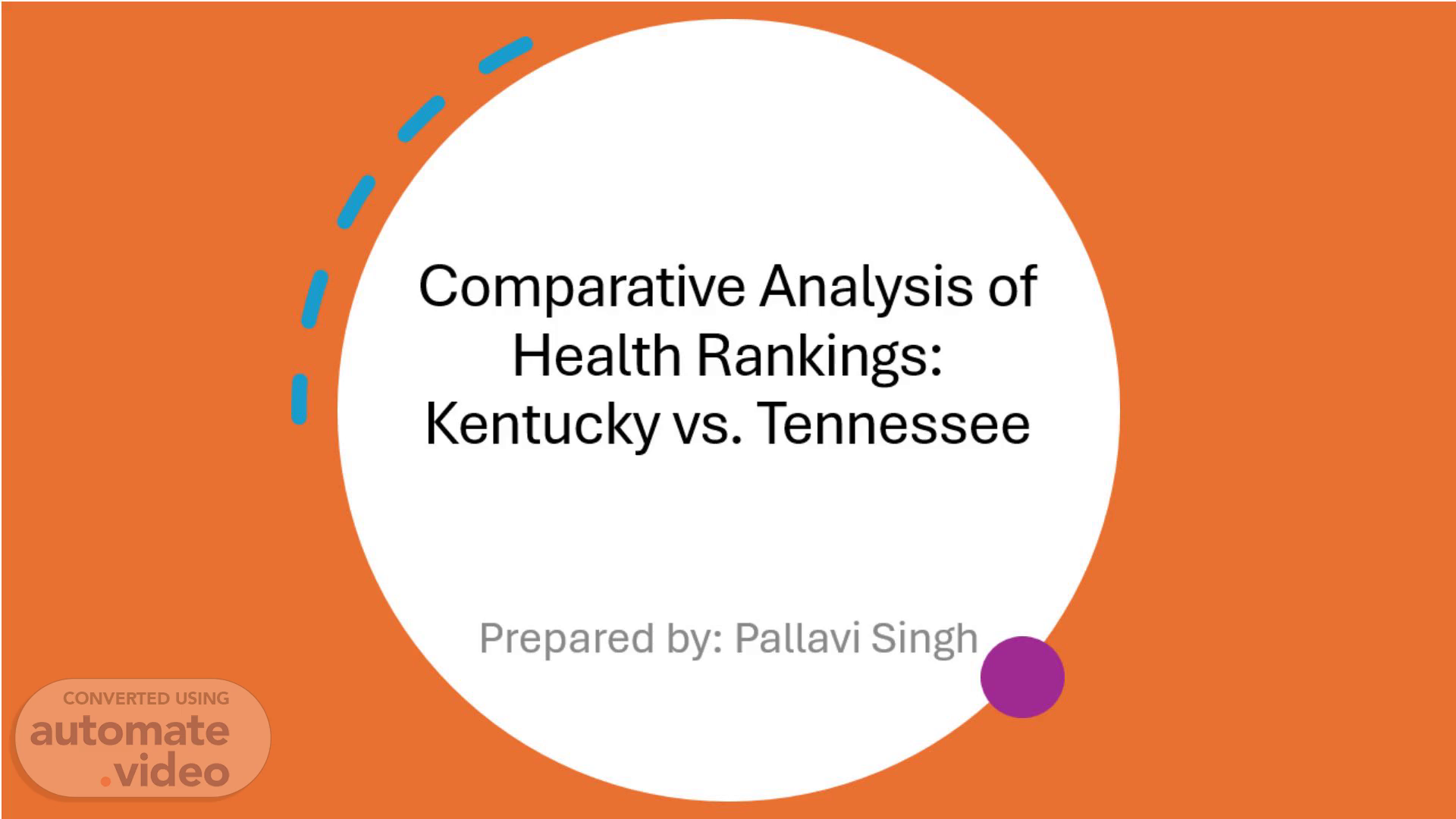
Comparative Analysis of Health Rankings: Kentucky vs. Tennessee
Scene 1 (0s)
[Audio] Today, I will present a comparative analysis of health rankings between two states in the United States..
Scene 2 (1s)
[Audio] By analyzing high school graduation rates, we can determine how well-prepared individuals are for future opportunities. Unemployment rates reveal the availability of job opportunities and the financial stability of residents. Income inequality highlights disparities in wealth distribution within a community. Understanding these factors is essential for developing effective strategies to improve population health outcomes..
Scene 3 (27s)
[Audio] The examination of these three key health factors provides valuable insights into the overall well-being of communities in Kentucky and Tennessee. By analyzing high school graduation rates, unemployment rates, and income inequality, we can better understand the social determinants of health that shape the lives of residents in these states.
Scene 4 (46s)
[Audio] The examination of three key indicators revealed disparities between Kentucky and Tennessee. The high school graduation rate measured the proportion of students completing their education within four years, providing valuable insights into educational outcomes and opportunities. The unemployment rate represented the percentage of job seekers actively looking for employment, shedding light on economic stability and workforce participation. Income inequality was assessed through the Gini coefficient, considering the distribution of wealth among the population, as well as the percentage of individuals living below the poverty line. This examination provided a deeper understanding of the socioeconomic disparities between the two states..
Scene 5 (1m 29s)
[Audio] Higher graduation rates are associated with better job opportunities and improved health literacy, both of which contribute to better health outcomes..
Scene 6 (1m 38s)
[Audio] Tennessee's unemployment rate is slightly lower than Kentucky's, which may positively influence residents' capacity to access vital services such as healthcare, housing, and nutritious food..
Scene 7 (1m 50s)
[Audio] Both states exhibit significant income inequality, as indicated by the Gini Coefficient. While Kentucky's level is marginally lower than Tennessee's, it still poses a challenge to public health. Research has consistently shown that high income inequality can lead to higher rates of chronic illnesses and limited access to preventive care. This finding underscores the importance of addressing socioeconomic disparities to promote better health outcomes..
Scene 8 (2m 17s)
[Audio] Higher graduation rates in Kentucky might contribute to long-term public health benefits, despite having a higher unemployment rate. On the other hand, Tennessee's lower unemployment rate could suggest better job prospects. Furthermore, Tennessee's higher income inequality compared to Kentucky may have implications for overall community well-being..
Scene 9 (2m 37s)
[Audio] The variations in health rankings between Kentucky and Tennessee may be due to differences in public health funding, where some areas receive more resources than others. Rural versus urban population distribution can also contribute to disparities, as cities often have better access to healthcare facilities and services. Job markets and educational systems may also play a role, as areas with higher employment rates and better-educated populations tend to have improved health outcomes. Furthermore, environmental factors such as urbanization and industrialization levels can influence health rankings..
Scene 10 (3m 14s)
[Audio] We recommend investing in workforce development, equitable education, and targeted economic policies to reduce unemployment and income gaps. State-level initiatives should collaborate with community-based organizations to enhance outreach and impact. Improving high school graduation rates can be achieved by enhancing educational programs. Job creation strategies and policies addressing income inequality must be developed to reduce unemployment and income gaps..
Scene 11 (3m 42s)
[Audio] Kentucky has implemented school-to-career pipeline programs in low-income areas, which have improved high school graduation rates, especially among low-income students. Tennessee has focused on job training and economic development programs to reduce unemployment. By addressing these underlying factors, we can establish a foundation for better health outcomes in the future..
Scene 12 (4m 4s)
[Audio] Addressing the disparities in health-related socioeconomic indicators between Kentucky and Tennessee can lead to significant improvements in health outcomes. By implementing evidence-based interventions, we can bridge the gaps and create more equitable health environments. Both states have the opportunity to reduce socioeconomic gaps and promote better health for their citizens..
Scene 13 (4m 26s)
[Audio] The sources we've used for our data and insights include County Health Rankings & Roadmaps from 2023, CDC WONDER from 2023, U S Bureau of Labor Statistics from 2023, National Center for Education Statistics from 2023, and U S Census Bureau from 2023. We appreciate your interest in our findings and are happy to address any questions you may have..